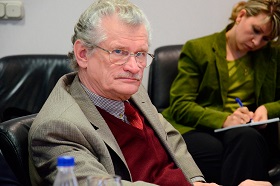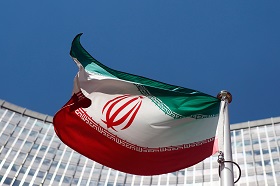On October 15, 2014, a trilateral meeting was held between US Secretary of State John Kerry, High Representative of the Union for Foreign Affairs and Security Policy Catherine Ashton and Iranian Foreign Minister Mohammad Javad Zarif. As organized between the six-nation group of powers and Iran, a historic comprehensive agreement will be signed on November 24, 2014 that will put an end to the controversy surrounding the Iranian nuclear issue and open the way for the lifting of economic sanctions against Tehran. How feasible is this outcome? What else should countries do to resolve a problem that has lasted for 35 years? Vladimir Sazhin, PhD in History, Senior Research Fellow at RAS Institute of Oriental Studies and RIAC expert, shares his insights on the situation.
On October 15, 2014, a trilateral meeting was held between US Secretary of State John Kerry, High Representative of the Union for Foreign Affairs and Security Policy Catherine Ashton and Iranian Foreign Minister Mohammad Javad Zarif. As organized between the six-nation group of powers and Iran, a historic comprehensive agreement will be signed on November 24, 2014 that will put an end to the controversy surrounding the Iranian nuclear issue and open the way for the lifting of economic sanctions against Tehran. How feasible is this outcome? What else should countries do to resolve a problem that has lasted for 35 years? Vladimir Sazhin, PhD in History, Senior Research Fellow at RAS Institute of Oriental Studies and RIAC expert, shares his insights on the situation.
In your opinion, have the recent talks between Iran and the P5+1 group on Tehran's nuclear program made any progress?
The progress will definitely be achieved because all the parties are very interested in resolving the Iranian nuclear issue. First of all, it is important for Iran and the US. It is these two countries that have confronted each other for the almost 35 years since the establishment of the Islamic Republic of Iran. Until recently, any formal negotiations between them were out of the question. However, after current Iranian President Hassan Rouhani, who is relatively liberal by Iranian standards, came to power, the emphasis in foreign policy – and on the issue of lifting sanctions in particular – has changed. Sanctions may be lifted only if the Iranian nuclear issue is resolved once and for all. Last year, the P5+1 group (also called the six-country group) and Iran worked very hard together. Seven rounds of talks were held and much was achieved. Over the past year, they managed to accomplish much more than in the previous 11 years.
The work is carried out in two formats. The first one is within the framework of the IAEA. It deals with technical issues discussed by nuclear physicists.
The second one is the P5+1 format. The six-nation group of powers includes the five permanent members of the UN Security Council and Germany. The issues discussed here are of a political nature related to the Iranian nuclear program. Both processes are taking place simultaneously.
Moreover, documents are already being drafted under the framework of negotiations between the six-country group and Iran. On October 22, 2014, two-day talks began between the experts of Iran and the P5+1 on the preparation of documents to be further discussed by the six-nation group representatives at a higher level.
According to experts, 95 percent of the final comprehensive agreement has already been agreed upon. The agreement aims at removing the concerns of the international community related to the development of Iran's nuclear program. The issue under discussion now is the scope of acceptable uranium enrichment in Iran as well as the methodology and the algorithm for lifting the sanctions imposed on the country.
The UN Security Council imposed sanctions on Iran in 2006. The most recent resolution was adopted in the summer of 2010. In addition, many states have imposed sanctions unilaterally. The most severe sanctions (involving Iran's banking and insurance system, as well as the oil and petrochemicals sector) were enforced in 2012 by the United States and the European Union, and later joined by many other countries. The 2012 sanctions delivered a heavy blow to the Iranian economy, forcing its leadership to make certain concessions on the nuclear issue to the six-power group. As of today, the possibility of reaching a full-fledged agreement appears quite real.
Most importantly, under the current conditions, the United States and Iran appear extremely interested in resolving the nuclear issue. During his election campaign, President Hassan Rouhani pledged to resolve the nuclear issue without prejudice to Iranian national interests. He also promised to put an end to the enmity between Iran and the West. In his last campaign, Barack Obama spoke of the need for resolving the Iranian issue as well.
However, the matter is complicated by the fact that there are many opponents to a reduction of tensions between the two countries, both in Iran and the United States. In the US, this role is played by the Republican Party, which believes that the US and the six-power group are compromising too much and allowing Iran to develop nuclear weapons in the future. In Iran, opposition comes from Hassan Rouhani’s political opponents, which represent conservative and radical circles, primarily the Army of the Guardians of the Islamic Revolution. They are likely to lose the money they are making from the arms race. In addition, there is a group of Shiite clerics who believe that Hassan Rouhani and his supporters are undermining the foundations of the Islamic revolution by making compromises with the West.
Most importantly, the administrations of both Hassan Rouhani and Barack Obama are interested in solving this problem. President Rouhani seeks to lift the sanctions on Iran and normalize relations with the West, as he sees in the West a potential investor and a supplier of advanced technology. The Iranian economy is now facing many problems, and it will be hard to solve them without foreign investment and advanced technology. Meanwhile, without the US, rapprochement with the European Union is far from likely too, no matter how profound the latter’s interest in it may be.
As for the United States, President Obama is trying to change the inimical status of the Islamic Republic of Iran. Barack Obama seeks to reshape US priorities in the region and establish a kind of American balance between Saudi Arabia, Israel and Iran. It is not accidental, that within a relatively short period of time, Washington has changed its position from demanding a complete halt to Iran’s uranium enrichment to recognizing Iran’s nuclear status. The issue of bringing Iranian achievements in the nuclear field to naught has been taken off the table. The issue of control is coming to the fore in the forthcoming comprehensive agreement. This involves the problem of Iran’s compliance with the terms of the Additional Protocol to the Safeguards Agreement with the IAEA.
Any country which has signed a Safeguards Agreement with the IAEA and has joined this organization, is obliged to grant IAEA inspectors access to its nuclear sites for control. Moreover, there is an Additional Protocol which provides for bringing these facilities under even tougher control. Thus, if a country has signed and is complying with the IAEA Additional Protocol, the International Atomic Energy Agency has the right to send its inspectors to the country to check any nuclear site at any time without prior arrangements. Incidentally, Iran signed the Additional Protocol in 2003 and for three years abided by its terms, although Iran's parliament Majlis did not ratify it.
However, after Mahmoud Ahmadinejad came to power in Iran in 2005, the country stopped complying with the terms of the Additional Protocol. Making the control issue part of the comprehensive full-fledged agreement will solve many problems.
It should also be noted that on November 24, 2013, Iran and the P5+1 group of international mediators signed the Joint Plan of Action (Geneva interim agreement), under which Iran pledged to freeze certain nuclear activities for six months (from January 20 until July 20, 2014) in return for sanctions relief worth approximately $4.2 billion.
A comprehensive agreement was to be signed by July 20, 2014. Iran complied with all the requirements, and the Americans, in turn, enabled Tehran access to frozen funds. But, unfortunately, the negotiators failed to reconcile the text of the agreement that was to be signed by July 20. It was therefore decided to extend talks until November 24, 2014.
One month remains to complete the work that is now in high gear. All major participants hope to succeed and prepare the document for signing before November 24, 2014. I don’t believe that the date of signing the agreement is that important. The really crucial issue is ensuring that the document is thorough and capable of resolving all the issues concerning Iran's nuclear program and the lifting of sanctions. Especially since the Obama-Biden Administration cannot do it without the approval of the Congress. The quality of the document is the main thing now.





